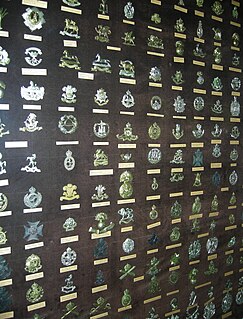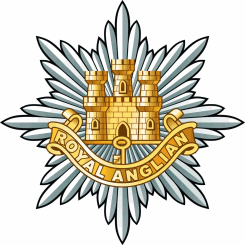
The Combined Cadet Force (CCF) is a youth organisation in the United Kingdom, sponsored by the Ministry of Defence (MOD), which operates in schools, and normally includes Army, Royal Navy and Royal Air Force sections. Its aim is to "provide a disciplined organisation in a school so that pupils may develop powers of leadership by means of training to promote the qualities of responsibility, self reliance, resourcefulness, endurance and perseverance".

A cap badge, also known as head badge or hat badge, is a badge worn on uniform headgear and distinguishes the wearer's nationality and/or organisation. The wearing of cap badges is a convention commonly found among military and police forces, as well as uniformed civilian groups such as the Boy Scouts, civil defence organisations, ambulance services, customs services, fire services etc.

The Royal Bermuda Regiment (RBR), formerly the Bermuda Regiment, is the home defence unit of the British Overseas Territory of Bermuda. It is a single territorial infantry battalion that was formed by the amalgamation in 1965 of two originally voluntary units, the mostly black Bermuda Militia Artillery (BMA) and the almost entirely white Bermuda Volunteer Rifle Corps (BVRC).
The hackle is a clipped feather plume that is attached to a military headdress.

The Royal Anglian Regiment is an infantry regiment of the British Army. It consists of two Regular battalions and one Reserve battalion. The modern regiment was formed in 1964, making it the oldest of the Line Regiments now operating in the British Army, and can trace its history back to 1685. The regiment was the first of the large infantry regiments and is one of the three regiments of the Queen's Division.
The East of England Regiment (EER) was the infantry unit of the Territorial Army of the East Midlands and East Anglia from 1 July 1999 to 1 April 2006. Upon the re-organisation of the infantry in 2006, the regiment became 3rd Battalion, Royal Anglian Regiment.

The uniforms of the British Army currently exist in twelve categories ranging from ceremonial uniforms to combat dress. Uniforms in the British Army are specific to the regiment to which a soldier belongs. Full dress presents the most differentiation between units, and there are fewer regimental distinctions between ceremonial dress, service dress, barrack dress and combat dress, though a level of regimental distinction runs throughout.

The 163rd Infantry Brigade was an infantry brigade of the British Army that saw active service during the First World War in Gallipoli and the Middle Eastern Theatre as part of the 54th Division. In the Second World War the brigade remained in the United Kingdom until it was disbanded in late 1943.

The Royal Regiment of Scotland is the senior and only Scottish line infantry regiment of the British Army Infantry. It consists of four regular and two reserve battalions, plus an incremental company, each formerly an individual regiment. However, most battalions maintain their former regimental pipes and drums to carry on the traditions of their antecedent regiments.
The Royal Scots Borderers, 1st Battalion, the Royal Regiment of Scotland is a Specialised Infantry Battalion of the Royal Regiment of Scotland. The battalion formed on 1 August 2006 when its antecedent regiments - the Royal Scots and the King's Own Scottish Borderers - amalgamated just after the formation of the Royal Regiment of Scotland in 2006.

The Cambridgeshire Regiment was an infantry regiment of the British Army, and was part of the Territorial Army. Originating in units of rifle volunteers formed in 1860, the regiment served in the Second Anglo-Boer War and the First and Second World Wars before losing its separate identity in 1961. Its lineage is continued today by the Royal Anglian Regiment.

The Suffolk Regiment was an infantry regiment of the line in the British Army with a history dating back to 1685. It saw service for three centuries, participating in many wars and conflicts, including the First and Second World Wars, before being amalgamated with the Royal Norfolk Regiment to form the 1st East Anglian Regiment in 1959 which, in 1964, was further amalgamated with the 2nd East Anglian Regiment, the 3rd East Anglian Regiment and the Royal Leicestershire Regiment to create the present Royal Anglian Regiment.

The Home Service Force was a Home Guard type force established in the United Kingdom in 1982. Each HSF unit was placed with either a Regular Army or Territorial Army regiment or battalion for administrative purposes and given that formation’s title, cap badge and recruited from volunteers aged 18–60 with previous British forces experience. It was introduced to guard key points and installations likely to be the target of enemy special forces and saboteurs, so releasing other units for mobile defence roles. It was stood down in 1992.
The Hong Kong Adventure Corps is a voluntary uniformed group subsidised by the Hong Kong government and the Hong Kong Jockey Club. It was created in 1995 with ties to the British Army's Army Cadet Force and Combined Cadet Force. Like the Hong Kong Sea Cadet Corps and Hong Kong Air Cadet Corps, the HKAC exists to serve the Hong Kong community. The HKAC's values are based in those of the British Army, providing a tough and challenging training with a distinctive military tone of discipline and esprit de corps.

Tactical recognition flash (TRF) is the official British military term for a coloured patch worn on the right arm of combat clothing by members of the British Army, Royal Navy and Royal Air Force. A TRF serves to quickly identify the regiment or corps of the wearer, in the absence of a cap badge. It is similar to, but distinct from, the DZ Flashes worn by members of Airborne Forces.

Berets were first used as headgear with military uniform in some European countries during the 19th century, and since the mid-20th century, have been a component of the uniforms of many armed forces throughout the world. Military berets are usually pushed to the right to free the shoulder that bears the rifle on most soldiers, but the armies of some countries, mostly within Europe, South America and Asia have influenced the push to the left.

The East Midland Brigade was an infantry brigade of the Territorial Force, part of the British Army, that was raised in 1908. As the name suggests, it commanded infantry battalions recruited in the East Midlands of England: Bedfordshire, Northamptonshire, Cambridgeshire and Hertfordshire. The brigade was an integral part of the East Anglian Division.
The 1st Northamptonshire Rifle Volunteers were a unit of the British Army raised from 1859 onwards as a group of originally separate Rifle Volunteer Corps (RVCs). They later became the 4th Volunteer Battalion of the Northamptonshire Regiment and saw action in the Gallipoli and Palestine campaigns during the First World War. Converted into a searchlight unit between the wars, they served in the defence of the United Kingdom and as an infantry regiment in liberated Norway during the Second World War. Postwar they continued in the air defence role until 1961 when they reverted to infantry as part of the Royal Anglian Regiment.

The 6th (Volunteer) Battalion, Royal Anglian Regiment was a part-time infantry unit of the British Army part of the Territorial Army (TA). Originally formed in 1971 from the expansion of many cadres, the battalion would eventually be disbanded in 1999 and formed sub-units in the new East of England Regiment. Today, the battalion's successors still form part of the Army Reserve (AR) component of the Royal Anglian Regiment's only remaining reserve unit, the 3rd (V) Bn.












